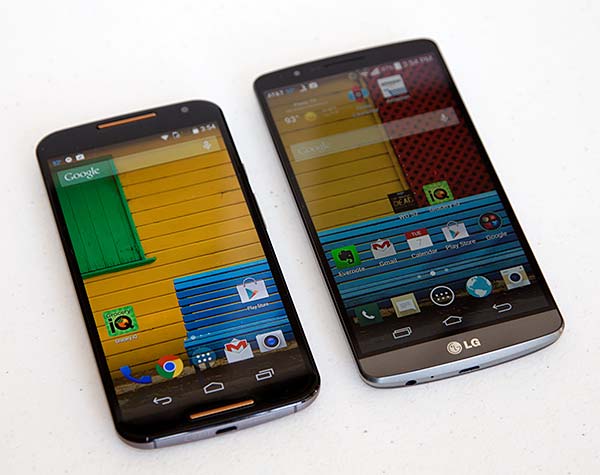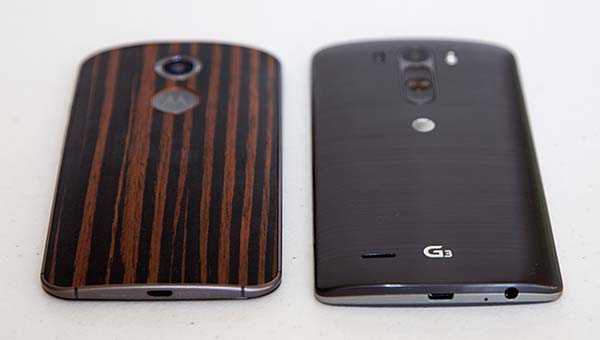|
Home > Android Phone Reviews > Moto X 2nd gen vs. LG G3 Comparison

Moto X (2014) vs. LG G3 Comparison Smackdown
Carriers: all major carriers for G3,
AT&T, Verizon and T-Mobile (unlocked) for Moto
Manufacturers: LG, Motorola
|
|
|

Posted October 8, 2014 by Lisa Gade, Editor
in Chief (twitter: @lisagade)
Two Android smartphones are competing for your dollars and heart. They share a similar form and size and they even run the same Android KitKat 4.4 OS. I'm talking about the incumbent LG G3 and the new Moto X 2nd edition, or 2014 edition. The LG G3 has a 5.5" inch display, but it's just a tiny bit bigger than the Moto X with its 5.2" display. They both have curved backs that are comfy in hand, and are surprisingly easy to hold thanks to those curves. They run the same CPU and both have 13MP rear cameras. So how do you decide?

If you're a Verizon Wireless or AT&T customer, you can get the LG G3 and Moto X 2nd gen at your local store. T-Mobile customers can buy the LG G3 in store, but you'll have to buy the unlocked Moto X 2014, aka Pure Edition, direct from Motorola's website. Sorry Sprint folks, there's currently no second gen X for Sprint's network.
Price
The LG G3 has been on the market a few months and the prices have dropped a bit. It costs between $580 and $600 full retail, depending on carrier. The Moto X starts at $499 for the 16 gig model, and the 32 gig model that matches the LG's storage capacity is $550. Add $25 more if you want a wood or leather back. Those prices are close enough to call it a draw; $25 to $50 for $500 and higher phones isn't significant. What about traditional 2 year contract pricing? The Moto X is $99 with contract on AT&T and Verizon, and the LG G3 is $99 and Verizon Wireless and $199 on AT&T. T-Mobile doesn't offer subsidized contracts on phones.
Display
There's the IPS crowd and AMOLED lovers, and thus there's no empirical winner. The LG G3 is one of the first phones with a 2k resolution 2560 x 1440 IPS display, and it is indeed wildly sharp. In fact the pixel density on both phones is so high that the unaided eye probably couldn't see the difference. The 2014 Moto X has a 1920 x 1080 AMOLED display that's super color saturated with inky blacks and extreme contrast. The question is do you love those crazy AMOLED colors or are you an IPS person who prefers more natural and accurate colors (the LG has fairly good color accuracy). In the Moto X's favor is that it looks brighter since AMOLED colors pop, even though both phones lack high brightness. And though the LG has an IPS panel, which are known for their wide viewing angles, the LG G3 looks dim off angle. I personally prefer IPS panels for reading ebooks and web pages, and AMOLED for watching videos and viewing photos. Another note about the LG G3: some describe colors as muted, likely because they've been using a Samsung or some other Super AMOLED phone recently. But that said, colors are a little less vivid than the HTC One M8 that uses an IPS-like panel, or the iPhone 6 Plus' IPS display.
Winner: that's up to you.

Performance
Both phones run on the same Qualcomm Snapdragon 801 2.5GHz CPU with Adreno 330 graphics. It's a tie. The LG G3 has 3 gigs of RAM vs. the 2 gigs of RAM on the Moto X 2014 edition, but LG's UI customizations and added software require more RAM than the AOSP vanilla Android on the Moto X.
The LG G3 has 32 gigs of storage for US models. The Moto X second edition is available with 16 or 32 gigs of storage (your choice).
Winner: Tie.
Benchmarks
| |
Quadrant |
3DMark Ice Storm Unlimited |
AnTuTu |
Geekbench 3 |
Sunspider JavaScript Test (lower is better) |
| Moto X |
22,170 |
19,924 |
44,340 |
972/2951 |
776 |
| LG G3 |
24,385 |
18,708 |
36,525 |
1004/2639 |
425 |
Taking off that Back Cover
The LG G3 has a removable battery and a microSD card slot under the back cover. Nice! The Moto X is a sealed unit with no microSD card slot and the battery is sealed inside.
Winner: LG G3
Camera
The LG G3 has one of the best cameras you'll find on an Android phone. It's great in good lighting and does a good job in poor lighting. If mobile photography is important to you, get the LG G3.
The Moto X 2nd edition has a better camera than the first generation Moto X, but that's faint praise. It's amazing to think that both the G3 and new Moto X use the same 13MP Sony sensor, yet the results are so different thanks to LG's better software and camera firmware (perhaps the lens and OIS help too). The Moto X is decent outdoors in good lighting and pretty weak indoors in just OK to dim lighting. If you take photos of your kids and pets at night in the living room with a few incandescence lights turned on, the LG G3 will take nice shots while the Moto X will render it a grainy and dim mess.
On the video front things look much better for the Moto X, and it takes good 1080p and 4k video. As you might expect, the G3 takes very good 1080p and 4k videos as well.
Winner: LG G3
Looks aren't Everything, but they Help
The LG G3 is a nice, clean and modern phone from the front. I really appreciate the lack of chrome and other accents that can easy make a phone look cheap or dated. The back isn't bad looking, and it's made of plastic designed to look like metal (at least the dark gray model, the white model doesn't look much like metal). Overall, it's a decent looking phone, but it won't win the beauty pageant when competing against the iPhone 5 and 6, the HTC One M8 or the second gen Moto X.
The Moto X has a metal frame that runs around the edges, and it's a tasteful nickel or gunmetal look (depending on whether you go with the white or black front). The back is available in 17 colors via MotoMaker, 4 different woods and 4 different leather colors. There are 10 accent colors to choose front. It's immediately personal and suited to your tastes, and Motorola's palette insures that you won't make something too ghastly. Moto phones have a distinct and very pleasing look with interesting and pleasing complex curves too. It's just a great looking phone, though some aren't fond of the ornamentation on top of the speaker grilles.
Winner: Moto X
There are quite a few more points to cover, so be sure to watch our video below!
|

